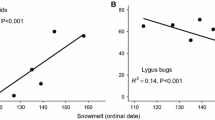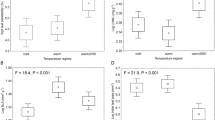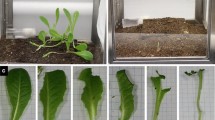Abstract
The net effect of climatic change on biotic interactions will depend on how each interacting species is individually affected. Elevated temperatures are predicted to have differential effects on species across trophic levels, due to asymmetric sensitivity to temperature changes. In this study, we examined the direct effects of three temperature regimes (16, 20 and 24 °C) that reflect present and, potentially, future climate conditions on the response of Salix spp. plants, an important bioenergy crop, and its most damaging herbivore (Phratora vulgatissima) and an efficient natural enemy (the omnivorous predator Orthotylus marginalis). We found that plant growth, herbivore oviposition and enemy egg-foraging rate correlated positively with temperature. In the event of elevated temperatures following global climatic changes, these species could potentially respond in tandem. Still, the strength of responses varied among species, with herbivore and natural enemy exhibiting a similar and steeper rate of response relative to plants. Additionally, the herbivore’s response was influenced by plant quality with altered oviposition rates depending on whether it was fed the (previously determined) resistant Salix dasyclados or susceptible S. viminalis. This indicates that host plant chemistry has the potential to mediate differential responses to temperature. Together, our results suggest that indirect effects of elevated temperatures, leading to a disruption of trophic associations, may be less likely or less severe in this tri-trophic system.


Similar content being viewed by others
References
Aguilar-Fenollosa E, Jacas JA (2014) Can we forecast the effects of climate change on entomophagous biological control agents? Pest Manag Sci 70:853–859
Alba C, Bowers MD, Blumenthal D, Hufbauer RA (2014) Chemical and mechanical defenses vary among maternal lines and leaf ages in Verbascum thapsus L. (Scrophulariaceae) and reduce palatability to a generalist insect. PLoS One 9:e104889. doi:10.1371/journal.pone.0104889
Awmack CS, Leather SR (2002) Host plant quality and fecundity in herbivorous insects. Annu Rev Entomol 47:817–844
Bale JS, Masters GJ, Hodkinson ID, Awmack C, Bezemer TM, Brown VK, Butterfield J, Buse A, Coulson JC, Farrar J, Good JEG, Harrington R, Hartley S, Jones TH, Lindroth RL, Press MC, Symrnioudis I, Watt AD, Whittaker J (2002) Herbviory in global climate change research: direct effects of rising temperature on insect herbivores. Glob Change Biol 8:1–16
Barton BT (2011) Local adaptation to temperature conserves topdown control in a grassland food web. Proc R Soc Lond B 278:3102–3107
Barton BT, Beckerman AP, Schmitz OJ (2009) Climate warming strengthens indirect interactions in an old-field food web. Ecology 90:2349–2351
Bascompte J, Jordano P, Olesen JM (2006) Asymmetric coevolutionary networks facilitate biodiversity maintenance. Science 312:431–433
Berggren Å, Björkman C, Bylund H, Ayres MP (2009) The distribution and abundance of animal populations in a climate of uncertainty. Oikos 118:1121–1126
Björkman C, Höglund S, Eklund K, Larsson S (2000) Effects of leaf beetle damage on stem wood production in coppicing willow. Agric For Entom 2:131–139
Björkman C, Dalin P, Eklund K (2003) Generalist natural enemies of a willow leaf beetle (Phratora vulgatissima): abundance and feeding habits. J Insect Behav 16:747–764
Björkman C, Bommarco R, Eklund K, Höglund S (2004) Harvesting disrupts biological control of herbivores in a short-rotation coppice system. Ecol Appl 14:1624–1633
Björkman C, Kindvall O, Höglund S, Lilja A, Bärring L, Eklund K (2011) High temperature triggers latent variation among individuals: oviposition rate and probability for outbreaks. PLoS One 6:e16590. doi:10.1371/journal.pone.0016590
Butt N, Seabrook L, Maron M, Law BS, Dawson TP, Syktus J, McAlpine CA (2015) Cascading effects of climate extremes on vertebrate fauna through changes to low-latitude tree flowering and fruiting phenology. Glob Change Biol 21:3267–3277
Calvo D, Molina JM (2005) Fecundity–body size relationship and other reproductive aspects of Streblote panda (Lepidoptera: Lasiocampidae). Ann Entomol Soc Am 98:191–196
Carmona D, Lajeunesse MJ, Johnson MTJ (2011) Plant traits that predict resistance to herbivores. Funct Ecol 25:358–367
Cornelissen T (2011) Climate change and its effects on terrestrial insects and herbivory patterns. Neotrop Entomol 40:155–163
Dalin P, Demoly T, Kabir MF, Björkman C (2011) Global land-use change and the importance of zoophytophagous bugs in biological control: Coppicing willows as a timely example. Biol Control 59:6–12
de Sassi C, Tylianakis JM (2012) Climate change disproportionately increases herbivore over plant or parasitoid biomass. PLoS One 7:e40557. doi:10.1371/journal.pone.0040557
DeLucia EH, Nabity PD, Zavala JA, Berenbaum MR (2012) Climate change: resetting plant–insect interactions. Plant Physiol 160:1677–1685
Dyer LA, Richards LA, Short SA, Dodson CD (2013) Effects of CO2 and temperature on tritrophic interactions. PLoS One 8:e62528. doi:10.1371/journal.pone.0062528
Facey SL, Ellsworth DS, Staley JT, Wright DJ, Johnson SN (2014) Upsetting the order: how climate and atmospheric change affects herbivore–enemy interactions. Curr Opin Insect Sci 5:66–74
Gillespie DR, Nasreen A, Moffat CE, Clarke P, Roitberg BD (2012) Effects of simulated heat waves on an experimental community of pepper plants, green peach aphids and two parasitoid species. Oikos 121:149–159
Gilman SE, Urban MC, Tewksbury J, Gilchrist GW, Holt RD (2010) A framework for community interactions under climate change. Trends Ecol Evol 25:325–331
Glynn C, Rönnberg-Wästljung A-C, Julkunen-Tiitto R, Weih M (2004) Willow genotype, but not drought treatment, affects foliar phenolic concentrations and leaf beetle resistance. Entomol Exp Appl 113:1–14
Harrington R, Woiwod I, Sparks T (1999) Climate change and trophic interactions. Trends Ecol Evol 14:146–150
Honěk A (1993) Intraspecific variation in body size and fecundity in insects: a general relationship. Oikos 66:483–492
Hoover JK, Newman JA (2004) Tritrophic interactions in the context of climate change: a model of grasses, cereal aphids and their parasitoids. Glob Change Biol 10:1197–1208
Irlich UM, Terblanche JS, Blackburn TM, Chown SL (2009) Insect rate temperature relationships: environmental variation and the metabolic theory of ecology. Am Nat 174:819–835
Ives AR, Carpenter SR (2007) Stability and diversity of ecosystems. Science 317:58–62
Jamieson MA, Trowbridge AM, Raffa KF, Lindroth RL (2012) Consequences of climate warming and altered precipitation patterns for plant-insect and multitrophic interactions. Plant Physiol 160:1719–1727
Jeffs CT, Lewis OT (2013) Effects of climate warming on host–parasitoid interactions. Ecol Entomol 38:209–218
Karp A, Shield I (2008) Bioenergy from plants and the sustainable yield challenge. New Phytol 179:15–32
Kendall DA, Hunter T, Arnold GM, Liggitt J, Morris T, Wiltshire CW (1996) Susceptibility of willow clones (Salix spp.) to herbivory by Phyllodecta vulgatissima (L.) and Galerucella lineola (Fab.) (Coleoptera, Chrysomelidae). Ann Appl Biol 129:379–390
Klapwijk MJ, Groebler BC, Ward K, Wheeler D, Lewis OT (2010) Influence of experimental warming and shading on host–parasitoid synchrony. Glob Change Biol 16:102–112
Kuzovkina YA, Weih M, Abalos Romero M, Belyaeva I, Charles J, Hurst S, Karp A, Labrecque M, McIvor I, Singh NB, Smart L, Teodorescu T, Trybush S, Volk T (2008) Salix: botany and global horticulture. Horticult Rev 34:447–489
Laws AN, Joern A (2015) Predator–prey interactions are context dependent in a grassland plant–grasshopper–wolf spider wood chain. Environ Entomol 44:519–528
Lehrman A, Torp M, Stenberg JA, Julkunen-Tiitto R, Björkman C (2012) Estimating direct resistance in willows against a major insect pest, Phratora vulgatissima, by comparing life history traits. Entomol Exp Appl 144:93–100
Montserrat M, Sahún RM, Guzmán C (2013) Can climate change jeopardize predator control of invasive herbivore species? A case study in avocado agro-ecosystems in Spain. Exp Appl Acarol 59:27–42
Norby RJ, Luo YQ (2004) Evaluating ecosystem responses to rising atmospheric CO2 and global warming in a multi-factor world. New Phytol 162:281–293
Ode PJ, Johnson SN, Moore BD (2014) Atmospheric change and induced plant secondary metabolites—are we reshaping the building blocks of multi-trophic interactions? Curr Opin Insect Sci 5:57–65
Parajulee MN, Shrestha RB, Leser JF, Wester DB, Blanco CA (2006) Evaluation of the functional response of selected arthropod predators on bollworm eggs in the laboratory and effect of temperature on their predation efficiency. Environ Entomol 35:379–386
Parmesan C (2006) Ecological and evolutionary responses to recent climate change. Annu Rev Ecol Evol Syst 37:637–669
R Development Core Team (2015) R: a language and environment for statistical computing. R Foundation for Statistical Computing, Vienna
Rall BC, Vucic-Pestic O, Ehnes RB, Emmerson M, Brose U (2009) Temperature, predator–prey interaction strength and population stability. Glob Change Biol 16:2145–2157
Robinet C, Roques A (2010) Direct impacts of recent climate warming on insect populations. Integr Zool 5:132–142
Romo CM, Tylianakis JM (2013) Elevated temperature and drought interact to reduce Parasitoid effectiveness in suppressing hosts. PLoS One 8:e58136. doi:10.1371/journal.pone.0058136
Rosenblatt AE, Schmitz OJ (2014) Interactive effects of multiple climate change variables on trophic interactions: a meta-analysis. Clim Change Responses 1:8
Rustad LE, Campbell JL, Marion GM, Norby RJ, Mitchell MJ, Hartley AE, Cornelissen JHC, Gurevitch J, GCTE-NEWS (2001) A meta-analysis of the response of soil respiration, net nitrogen mineralization, and aboveground plant growth to experimental ecosystem warming. Oecologia 126:543–562
Sentis A, Hemptinne J-L, Brodeur J (2013) Effects of simulated heat waves on an experimental plant–herbivore–predator food chain. Glob Change Biol 19:833–842
Smith MD, La Pierre KJ, Collins SL, Knapp AK, Gross KL, Barrett JE, Frey SD, Gough L, Miller RJ, Morris JT, Rustad LE, Yarie J (2015) Global environmental change and the nature of aboveground net primary productivity responses: insights from long-term experiments. Oecologia 177:935–947
Suttle KB, Thompsen MA, Power ME (2007) Species interactions reverse grassland responses to changing climate. Science 315:640–642
Tylianakis JM, Didham RK, Bascompte J, Wardle DA (2008) Global change and species interactions in terrestrial ecosystems. Ecol Lett 11:1351–1363
Voigt W, Perner J, Davis AJ, Eggers T, Schumacher J, Bährmann R, Fabian B, Heinrich W, Köhler G, Lichter D, Marstaller R, Sander FW (2003) Trophic levels are differentially sensitive to climate. Ecology 84:2444–2453
Voigt W, Perner J, Jones H (2007) Using functional groups to investigate community response to environmental changes: two grassland case studies. Glob Change Biol 13:1710–1721
Weih M (2001) Evidence for increased sensitivity to nutrient and water stress in a fast-growing hybrid willow compared with a natural willow clone. Tree Physiol 21:1141–1148
Wheeler AG (2001) Biology of the plant bugs. Cornell Univ Press, New York
Wu Z, Dijkstra P, Koch GW, Peuñelas J, Hungate BA (2011) Responses of terrestrial ecosystems to temperature and precipitation change: a meta-analysis of experimental manipulation. Glob Change Biol 17:927–942
Zvereva EL, Kozlov MV (2006) Consequences of simultaneous elevation of carbon dioxide and temperature for plant–herbivore interactions: a metaanalysis. Glob Change Biol 12:27–41
Acknowledgments
We thank Karin Eklund and Hans Johansson for practical help, Mikael Andersson for valuable discussions about statistics, and Richard Hopkins for editing earlier versions of the manuscript. CB and MW acknowledge financial support from the Swedish Energy Agency and the Faculty of Natural Resources and Agricultural Sciences at SLU (SAMBA-project), the MISTRA-funded project “Future Forests” and the Lamm Foundation.
Author information
Authors and Affiliations
Corresponding author
Ethics declarations
Conflict of interest
The authors declare that they have no conflict of interest.
Additional information
Handling Editors: Rupesh Kariyat and Heikki Hokkanen.
Rights and permissions
About this article
Cite this article
Puentes, A., Torp, M., Weih, M. et al. Direct effects of elevated temperature on a tri-trophic system: Salix, leaf beetles and predatory bugs. Arthropod-Plant Interactions 9, 567–575 (2015). https://doi.org/10.1007/s11829-015-9401-0
Received:
Accepted:
Published:
Issue Date:
DOI: https://doi.org/10.1007/s11829-015-9401-0




